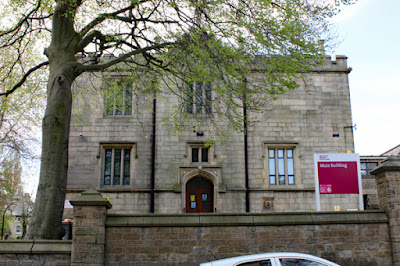 |
| Grotesques on the Sheffield Hallam University Main Building |
When planning my explorations of urban Sheffield for 2021, my intention had always been to find some interesting examples of stone built architecture, which would add to my existing knowledge of the building stones of Sheffield. Furthermore, in addition to providing some exercise during the continuing COVID-19 Pandemic, it was a good way to discover parts of the city that I would be very unlikely to visit without having a specific reason.
 |
| A view of the Broomhall Estate on Google Earth |
One of these is the Broomhall Estate, which I had passed by very many times when travelling along the Ecclesall Road and, having briefly surveyed the stonework at Hunters Bar and Pomona Street Board Schools, I went to photograph some of the many listed buildings that are found here – starting at Collegiate Crescent.
 |
| The 1855 Ordnance Survey map of the Broomhall Estate |
On the 1855 Ordnance Survey map, the area comprised largely undeveloped land centred around Broom Hall, which was bounded by Collegiate Crescent to the west and north, Hanover Street to the east and Ecclesall New Road to the south.
 |
| The 1894 Ordnance Survey map of the Broomhall Estate |
The rapid expansion of the Sheffield steel industry then led to the demand for suburban villas, with the park like layout of the development incorporating existing mature trees, new trees and shrubberies in the large open spaces between the houses - many of which were occupied by manufacturers of steel, cutlery and edge tools.
 |
| Collegiate Hall |
At its southern end is Collegiate Hall, where the original Jacobean Revival house, dated 1835, is thought to be by JG Weightman, an architect who trained in the offices of Sir Charles Barry and later formed a partnership with Matthew Ellison Hadfield – a practice that designed some of Sheffield’s most notable churches and other historic buildings.
 |
| The original Jacobean Revival house at Collegiate Hall |
Its uniform cream coloured masonry suggests that it is another example of Crawshaw Sandstone but, on this occasion, I was mainly concerned with taking photos for the British Listed Buildings website and didn’t examine it closely.
The Sheffield Hallam University Main Building, however, from a distance looks like it has been built in a different sandstone. Its large, well squared ashlar blocks and matching quoins have developed a greyish patina, which is not typical of the best medium grained gritstones from Derbyshire and West Yorkshire that are often seen in Sheffield.
 |
| The east end of the Sheffield Hallam University Main Building |
Looking at the photographs of the grotesques that surmount the east gable, the sandstone is seen to be very coarse in texture, but not obviously pebbly like the Chatsworth Grit, which makes me think that, if quarried in Sheffield, it could be from the Loxley Edge Rock.
 |
| Grotesques on the Sheffield Hallam University Main Building |
The lodge, which was built approximately 15 years after the main building, again has a very different character, with the colour of the walling stone being different to the massive sandstone used for the dressings.
 |
| The lodge |
Although I have seen no documentary evidence that records the provenance of any of the sandstones that I had so far seen on Collegiate Crescent, I could detect various differences in the colours and textures. This variation is yet again seen in the adjoining Oaklands building – and this highlights the value of the experience gained by devising the now dismantled Triton Stone Library and undertaking subsequent stone matching work.


No comments:
Post a Comment